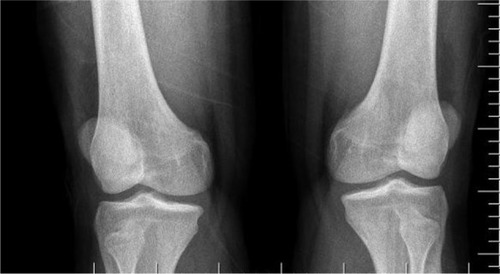Abstract
We describe a case of bilateral septic knee arthritis that followed the administration of methotrexate for nonsurgical termination of an ectopic pregnancy. We believe that methotrexate is a relatively effective alternative to surgery in patients with early unruptured tubal pregnancies, but suggest that it be used with caution in view of possible septic events.
Introduction
Methotrexate (MTX) is a folic acid antagonist and cell cycle-specific antimetabolite. While still an important component of hematological and solid tumor treatment regimens and ectopic pregnancies, low-dose MTX is now used to treat many autoimmune disorders, including Crohn’s disease, rheumatoid arthritis, and psoriasis. MTX-related hematological toxicity includes leukopenia, thrombocytopenia, megaloblastic anemia, and pancytopenia.Citation1,Citation2 In the circulation, 50% of MTX is protein-bound. It exhibits particular affinity for hepatocytes, myeloid precursors, red blood cells, and fibroblasts. It is converted to its active polyglutamate metabolite, which persists for months and allows weekly dosing. Excretion is mostly renal and, to a lesser extent, biliary.Citation3 MTX is regarded as an important, beneficial drug, but side effects should be monitored carefully.
Septic arthropathy is an unusual complication of pregnancy. The causative organism is typically Staphylococcus aureus. It can quickly lead to irreversible arthropathy and disability. Factors predisposing to septic arthritis pertinent to the gravida include diabetes, rheumatoid arthritis, drug abuse, a prior intra-articular steroid injection, or trauma.Citation4 Bilateral simultaneous knee septic arthritis was identified in this case, which has, to our knowledge, not been reported before.
Case report
A 25-year-old female, gravida 3, was admitted to the outpatient gynecology clinic complaining of abdominal pain and vaginal bleeding after 6 weeks of amenorrhea. Her previous menstrual cycles had been regular at 30 days, with average flow and no dysmenorrhea.
She had tenderness in the right lower quadrant of the abdomen, with normal vital signs. Transvaginal ultrasonography showed an empty uterine cavity and a gestational sac in the right adnexa, with no fetal cardiac activity, and there was no intra-abdominal free fluid. Laboratory tests showed an hCG level of 585 mIU/mL.
A single dose of MTX (50 mg/m2) was administered intramuscularly on day 1, and the hCG was 19.1 (minute 5) and 9.8 mIU/mL, respectively, on days 4 and 7. The patient’s liver function tests were normal and an additional dose of MTX was given. Subsequently, the hCG levels decreased. After the treatment, however, she developed pain and swelling of both knees.
On examination, she was afebrile and appeared well. Both knees were swollen and tender. A blood count revealed a hemoglobin of 12 g/dL (normal range 12–16 g/dL), total white blood cells at 13,600/L (normal range 3,600–10,000/L), and platelets at 576,000/L (normal range 130,000–400,000/L). The erythrocyte sedimentation rate was 100 mm/h (normal range 0–20 mm/h), and the C-reactive protein (CRP) 43 mg/L (normal range 0–7 mg/L). A direct radiographic evaluation was normal (). She had no comorbidities. Joint ultrasonography showed anterior soft tissue swelling with a thickened synovium and fluid collections measuring 1.0×0.9×2 cm in the right knee and 1.1×0.9×1.8 cm in the left. She was diagnosed with bilateral septic arthritis and underwent arthroscopic debridement and washout.
In the operating room, the puncture wound was extended about 1 cm in both directions. Pus was expressed with manual manipulation. A moderate amount of pus remained in both joints. Arthroscopic debridement and irrigation were done to break up any adhesions in the joint and to ensure that there were no pockets of pus or anything walled off, such as an abscess or phlegmon; culture antibiogram evaluation done and both joints were irrigated with approximately 3 L of saline. A Hemovac drain was placed in each joint. The wound cultures grew Gram-positive cocci (S. aureus) resistant to ampicillin, so vancomycin was started. The patient improved rapidly after the surgery. Active and passive movement increased to a total of 90°.
Discussion
Ectopic pregnancy is a gynecological emergency and a serious complication of early pregnancy because of the association with maternal morbidity and mortality in the first trimester.Citation5 Septic arthritis is an orthopedic emergency and a serious complication because of cartilage tissue damage. Factors predisposing to septic arthritis pertinent to the gravida include diabetes, rheumatoid arthritis, intravenous drug abuse, a prior intra-articular steroid injection, or trauma. Joint pain in pregnancy has a large differential diagnosis, including trauma, bacterial or viral arthropathy, collagen vascular disease, and enteropathic (inflammatory bowel disease) arthritis. Smaller, more distal joints are easier to assess than larger, more central joints. Nonetheless, joint destruction can occur with either. The patient’s history and concomitant illness provide useful clues to the origins of the arthritis.Citation6,Citation7
Immunosuppressants have been the mainstay of treatment for various diseases for many years. Treatments have led to a change in the classical presentation of acute bone, joint, and soft tissue infections. The normal findings of severe pain and tenderness on examination can be absent or simply mimic a typical exacerbation of a chronic joint condition.Citation8,Citation9
We present a unique case of bilateral septic arthritis in a patient treated with MTX for ectopic pregnancy. We hope that this article will enable physicians to appreciate the changing face of septic arthritis in the modern era of immunosuppressant treatments.
Disclosure
The authors report no conflicts of interest in this work.
References
- HuffmanDHWanSHAzarnoffDLHogstratenBPharmacokinetics of methotrexateClin Pharmacol Ther1973145725794723265
- CheungKKChowKMSzetoCCTaiMHKwanBCLiPKFatal pancytopenia in a hemodialysis patient after treatment with low-dose methotrexateJ Clin Rheumatol200915417718019502905
- NevesCJorgeRBarcelosAA teia de toxicidade do metotrexato [The network of methotrexate toxicity]Acta Reumatol Port2009341134 Portuguese19449473
- AlmoujahedMOKhatibRBaranJPregnancy-associated pyogenic sacroiliitis: case report and reviewInfect Dis Obstet Gynecol200311535712839633
- ChenCHLeeWLChiuLHSunHDLiuWMWangPHA cohort study to evaluate the effectiveness of laparoscopic-guided local injection of etoposide in the management of women with unruptured tubal pregnancyFertil Steril20119665465821737074
- SharffKARichardsEPTownesJMClinical management of septic arthritisCurr Rheumatol Rep20131533223591823
- DeNoblePHGonzalezDSeptic arthritis of the shoulder following elective termination of pregnancyJ Shoulder Elbow Surg200918e5e619243978
- Bourré-TessierJHaraouiBMethotrexate drug interactions in the treatment of rheumatoid arthritis: a systematic reviewJ Rheumatol20103771416142120436072
- Murav’evIuVGridnevaGIKarateevDEEvaluation of methotrexate effect on the acute-phase response in rheumatoid arthritis after 12-week treatmentKlin Med (Mosk)20149235963 Russian25269199

